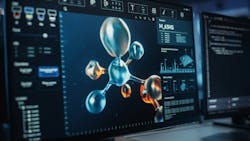AI Predicts Chemical Reactions Using Physical Laws
While many attempts at reaction prediction only look at the final products, “we want to track all the chemicals, and how the chemicals are transformed” throughout the reaction process from start to end,” Joung says.
The team addressed this by adapting a 1970s method from chemist Ivar Ugi that uses a bond-electron matrix to represent electrons in reactions. Their FlowER system uses this matrix representation to explicitly track all electrons throughout the reaction process, ensuring none are spuriously added or deleted. This approach conserves both atoms and electrons simultaneously.
The model was trained on over a million chemical reactions from U.S. Patent Office databases and matches or outperforms existing systems while providing much better validity and conservation. Unlike previous work, FlowER anchors its predictions in experimentally validated data rather than purely theoretical mechanisms.
Current limitations include gaps in metal-based and catalytic reactions, as the training data didn't extensively cover these areas. The system is freely available on GitHub as open-source software.
Future plans include expanding the model's understanding of metals and catalytic cycles. Long-term goals involve using the system to discover new complex reactions and elucidate novel mechanisms. The work represents a significant step toward AI systems that can reliably predict chemical reactions while respecting fundamental physical laws.
“We’re incredibly excited about the fact that we can get such reliable predictions of chemical mechanisms” from the existing system,” says senior author Connor Coley, who is the Class of 1957 Career Development Professor in the MIT departments of Chemical Engineering and Electrical Engineering and Computer Science. “It conserves mass, it conserves electrons, but we certainly acknowledge that there’s a lot more expansion and robustness to work on in the coming years as well.”
